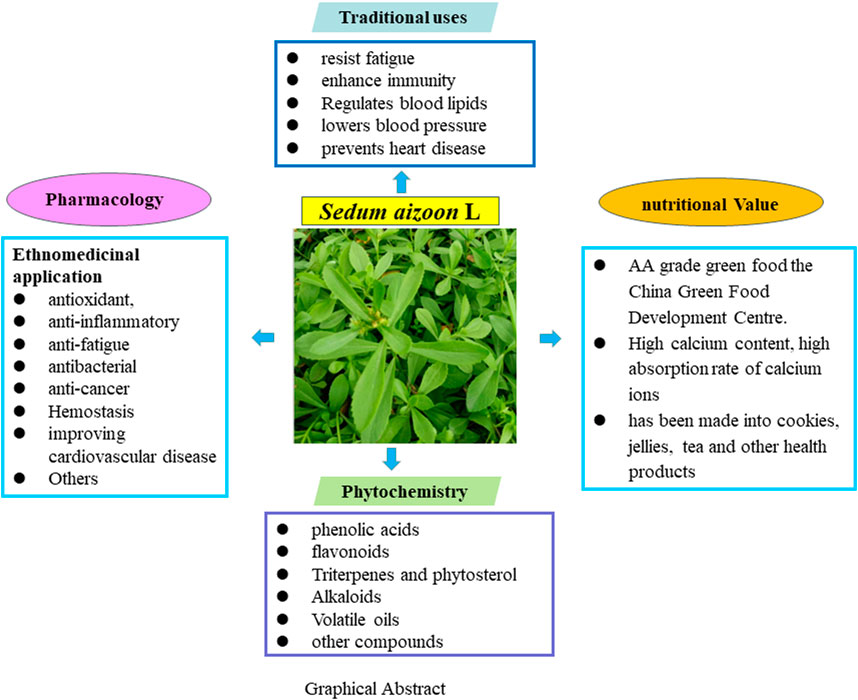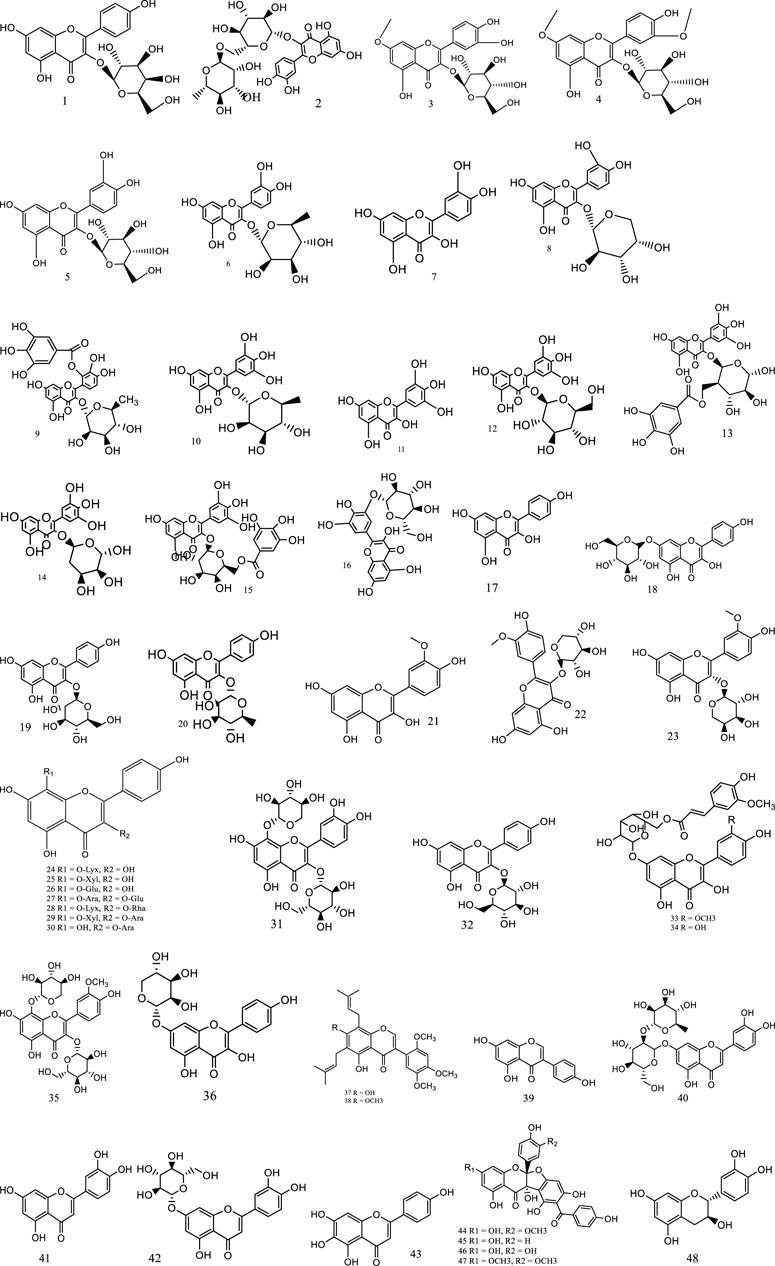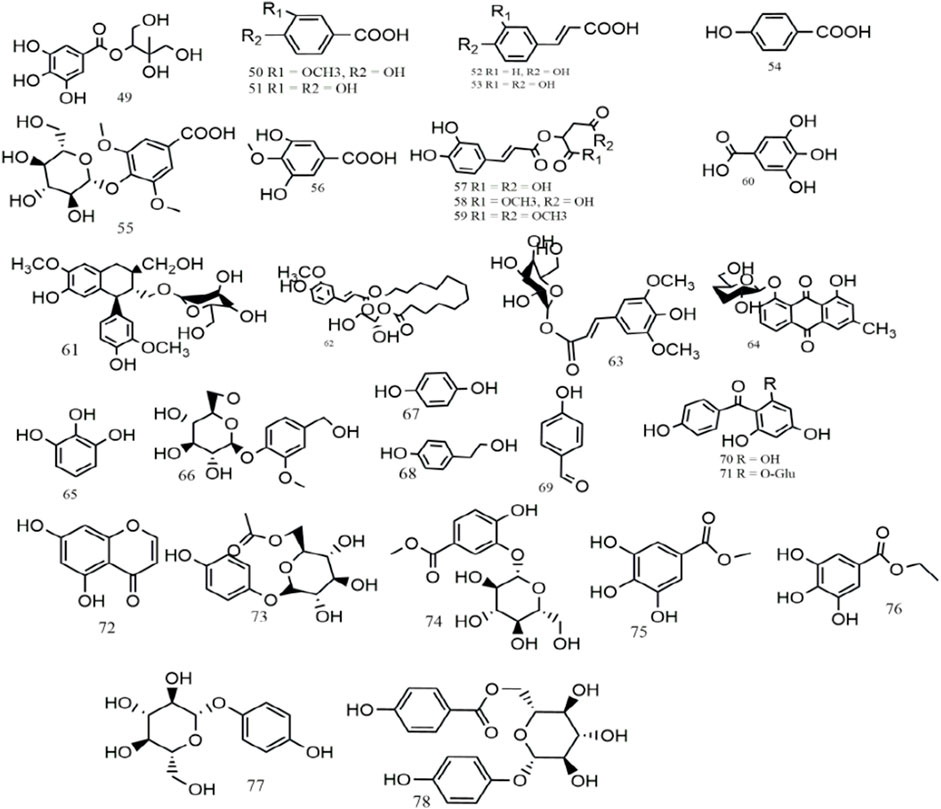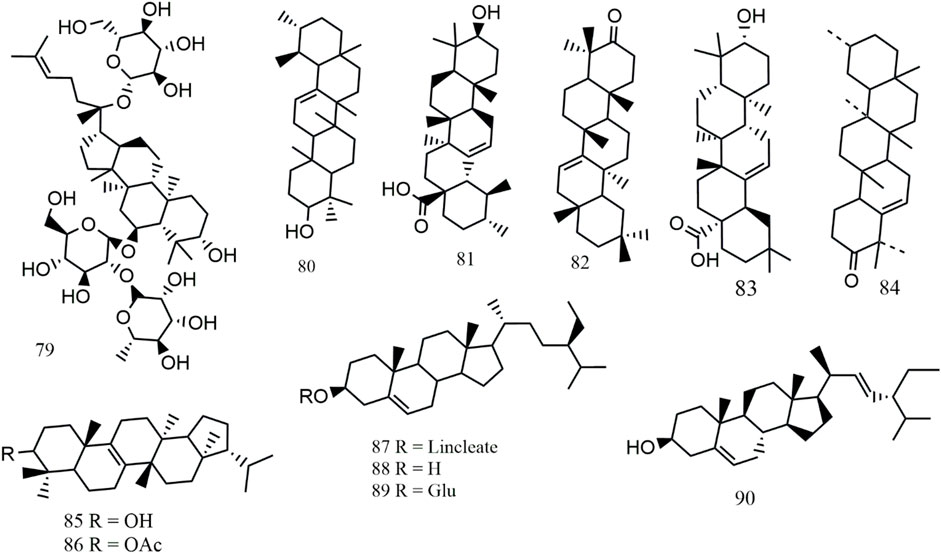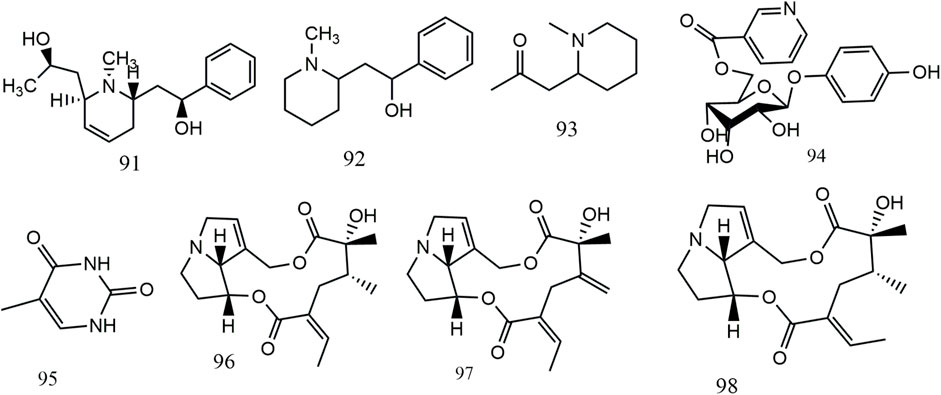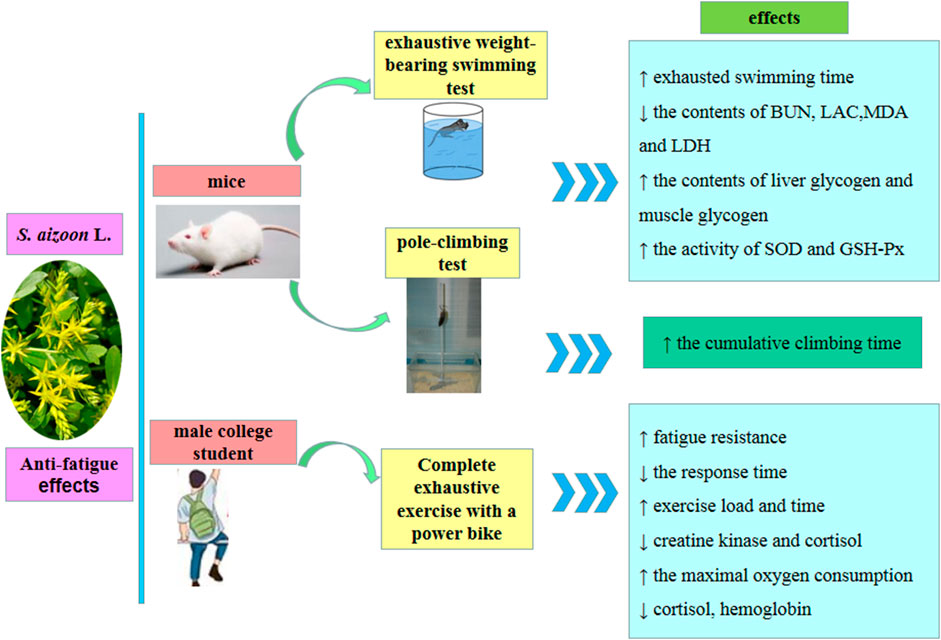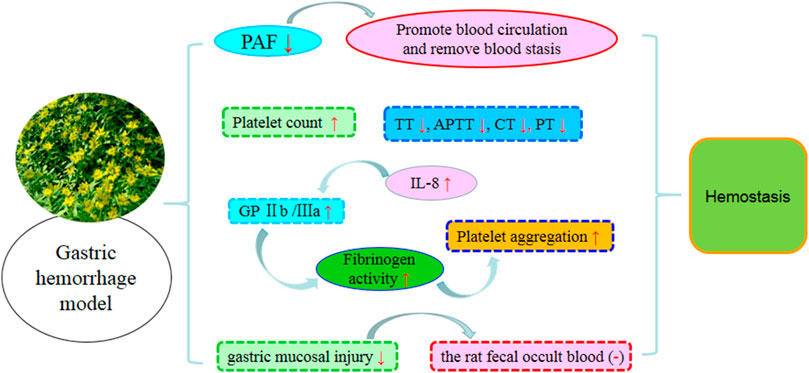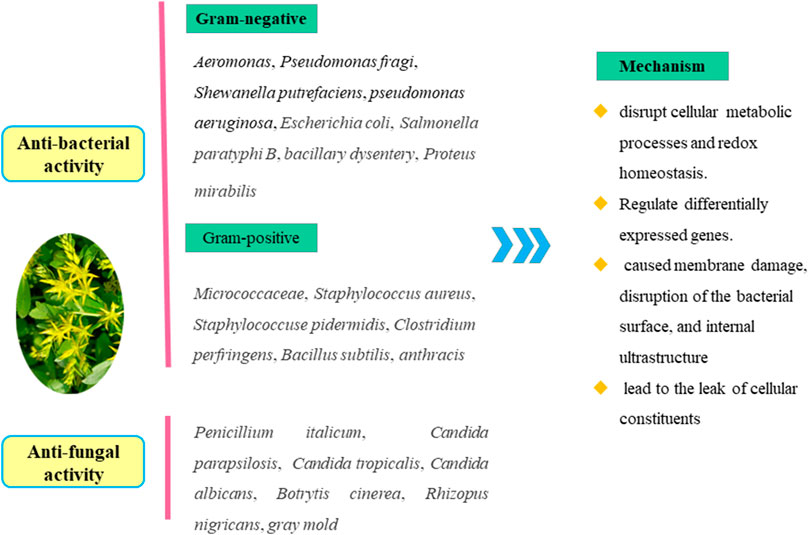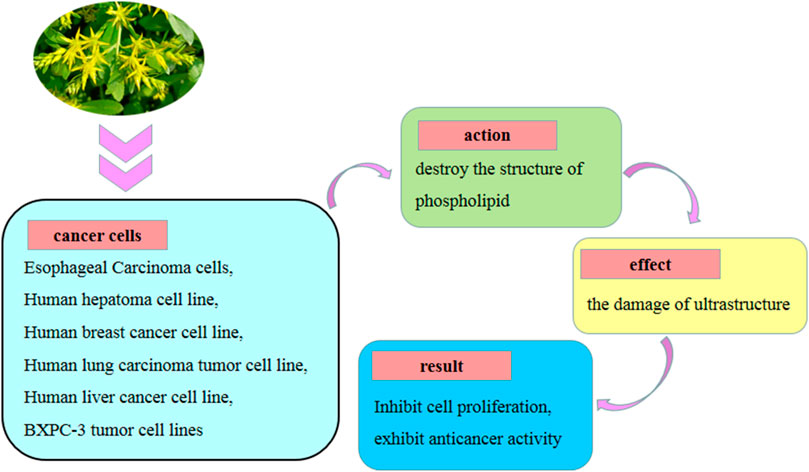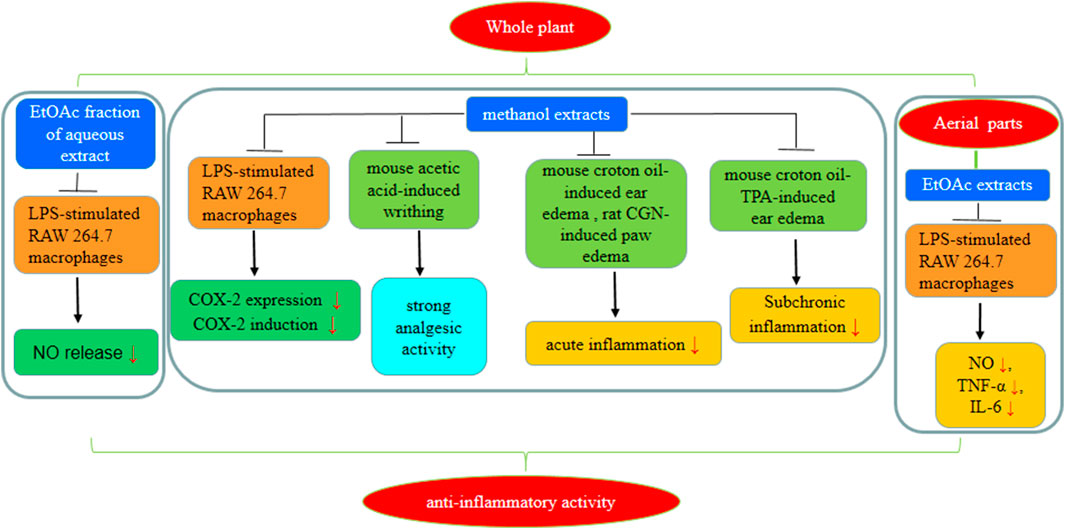- 1School of Pharmaceutical Sciences, Hubei University of Medicine, Shiyan, China
- 2Hubei Key Laboratory of Wudang Local Chinese Medicine Research, Shiyan, China
- 3Hubei Provincial Technology and Research Center for Comprehensive Development of Medicinal Herbs, Shiyan, China
In China, Russia, Mongolia, Japan, North Korea, and Mexico, Sedum aizoon L. (S. aizoon) is used as an edible plant. Up to now, over 234 metabolites, including phenolic acids, flavonoids, triterpenes, phytosterols, and alkaloids, among others, have been identified. In addition to its antioxidant, anti-inflammatory, anti-fatigue, antimicrobial, anti-cancer, and hemostatic activities, S. aizoon is used for the treatment of cardiovascular disease. This paper provides an overview of the history, botany, nutritional value, traditional use, phytochemistry, pharmacology, toxicology, and quality control of S. aizoon.
Highlights
• S. aizoon L. is frequently prescribed in both China and other countries as a traditional folk herbal remedy for various diseases
• This review contributes to updating the herbalogical textual research, traditional use, botany, phytochemistry, pharmacology, toxicity, and nutritional value and quality control of S. aizoon L.
• In earlier literature, there was no systematic review of S. aizoon L
1 Introduction
Sedum aizoon L. (Chinese name:景天三七) is a perennial herbaceous plant that is widely distributed in China, Russia, Mongolia, Japan, North Korea, and Mexico. It is a member of the Sedum genus in the Sedum family (Crassulaceae) (Guo and Lin, 2007). Its name is also consistent with the plant name recorded in “The Plant List” (http://www.theplantlist.org), which is now incorporated into the requirement for traditional medicine in the provinces of Jiangsu and Fujian (Jia et al., 2014). It is one of the renowned “Taibai seven medicine (太白七药)” in the Qinling Mountains, which has the effects of dispersing blood stasis, stopping bleeding, tranquilizing the mind, detoxifying, and analgesia, and is used in the treatment of various kinds of bleeding, palpitations, and insomnia. Growing in the natural environment, S. aizoon is a unique pest-free plant that does not require pesticides during its whole phenological cycle and has been designated as AA grade green food by the China Green Food Development Center. Its fresh stems and leaves are consumed as vegetables (Xue, 2015).
Despite the fact that the phytochemistry and ethnopharmacology of S. aizoon have been previously reviewed, a comprehensive study linking its bioactive metabolites with its pharmacological properties is lacking. Therefore, this paper provides an overview of the history, botany, nutritional value, traditional use, phytochemistry, pharmacology, toxicology, and quality control of S. aizoon.
2 Materials and methods
Information about S. aizoon was gathered from scientific literature sources, including PubMed, Baidu Scholar, Google Scholar, Web of Science, SciFinder, CNKI, Wanfang, the Plant List (www.theplantlist.org), and books. The history, nutritional value, traditional uses, botany, phytochemistry, pharmacology, toxicology, and quality control or a combination between them was used as keywords to search for data up to July 2023. Approximately, 767 research studies of S. aizoon were gathered from various databases. With the removal of duplicate literatures, 300 literatures were selected according to research purpose, relevance, and article type. The articles which contained information apart from that mentioned above or written in languages rather than English were also excluded. ChemBioDraw Ultra version 14.0 was used to draw chemical structures.
3 History and traditional uses
3.1 History
S. aizoon was first recorded in “Jiu Huang Ben cao” (救荒本草) (Ming Dynasty), which is the earliest book with agronomy and botany as its monograph on the history of China. Later, it was also included in many other famous works on Chinese herbal medicine, including “Wild Vegetables Bo lu” (野菜博录) (Ming Dynasty), “Plants Ming Shi Tu Kao” (植物名实图考), and “Discussion on varieties of Chinese medicinal materials” (中药材品种论述).
The medicinal parts of S. aizoon were roots and grass in S. aizoon, and S. kamshaticum. S. aizoon has more than 60 synonyms and is distributed in more than 20 provinces or autonomous regions. In addition, the herb and the syrup were included in the Pharmacopoeia of the People’s Republic of China (Part I) (1977 edition) (Chinese Pharmacopoeia Committee, 2005).
3.2 Traditional uses
In folk medicine, the flat and sweet whole herb and the roots of S. aizoon are widely used for dispersing blood stasis and stopping blood bleeding. For instance, daily administration of 60–90 g of S. aizoon decoction can treat bleeding symptoms, including hemoptysis, bleeding gums, epistaxis, gingival bleeding, and internal bleeding. The fresh juice was effectively used for the treatment of leukemia, aplastic anemia, thrombocytopenic purpura, hemoptysis, and different forms of bleeding (i.e., gingival, digestive tract, and hematuria) (Chinese herbal medicine research group, 1971). In addition, ancient medical classics, such as Li Shizhen’s “Compendium of Materia Medica” (本草纲目), Chen Shiduo’s “New Compilation of Materia Medica” (本草新编), and Zhang Xichun’s “Intergrating Chinese And Western Medicine” (医学衷中参西录), explicitly stated that S. aizoon had good hemostasis and analgesic function, which was known as “the god medicine for hemostasis” (止血神药). It is also used as a heart and mind tranquillizing agent with an excellent effect on hysteria palpitation, restlessness, hypertension, and rheumatic heart disease (Chen, 2003). Likewise, the detoxifying and clearing heat effects have also been reported.
Of note, S. aizoon has a long history as both an edible and medicinal herb. For example, vegetables with S. aizoon’s stems and leaves as metabolites have good nutritional value. “Jiu Huang Ben Cao” (救荒本草) in the Ming Dynasty stated that the regular consumption of the fresh, tender stems and leaves of S. aizoon can promote blood circulation and calm the heart.
4 Nutritional value
The tender stems and leaves contain moisture (87 g), protein (2.1 g), fat (0.7 g), carbohydrate (8.0 g), crude fiber (1.5 g), ash (1.2 g), energy (196.65 KJ), Ca (315 mg), P (39 mg), Fe (3.2 mg), carotene (2.54 mg), vitamin B1 (0.05 mg), vitamin B2 (0.07 mg), vitamin PP (90 mg), and vitamin C (90 mg) (Yi, 2000; Liu et al., 2012). Owing to its unique aroma and taste, S. aizoon is used for the preparation of cookies, jellies, and tea (Wang, 2013).
5 Botany
5.1 Geographical repartition
S. aizoon belongs to the genus Sedum of the Crassulaceae family. There are approximately 600 species widely distributed in the temperate and subtropical regions of the northern hemisphere with Mexico being the largest center of origin and diversity of Sedum species.
5.2 Morphology
S. aizoon is an annual or perennial, succulent herb, growing in clusters and has a strong ability to bifurcate. S. aizoon has coarse, woody rhizomes that resemble ginseng in form. The stems are erect, cylindrical, and glabrous, which can reach heights of 15–50 cm. At each node, the stems carry just one leaf, which is nearly opposite on both sides. The leaves are 2.5–5 cm long, 5–12 mm wide, obovate or long oval in shape, and broad and thick with more juice. Additionally, they feature a cuneate base, a serrated border toward the apex, a moderately rounded top, and few sessile leaves. The loose, terminal verticillaster contains ten stamens that are around the same length as the petals, five distinct pistils that are slightly longer than the stamens, five orange–yellow petals with lancolate, sharp tips, and five sepals with blunt ends. Follicles are either reddish or brown in color and are grouped in a star pattern. Seeds are obovate, smooth, have wings along the edge, and have a wider apical. Flowers usually bloom in summer. The photos of S. aizoon are pictured and shown in Figure 1.
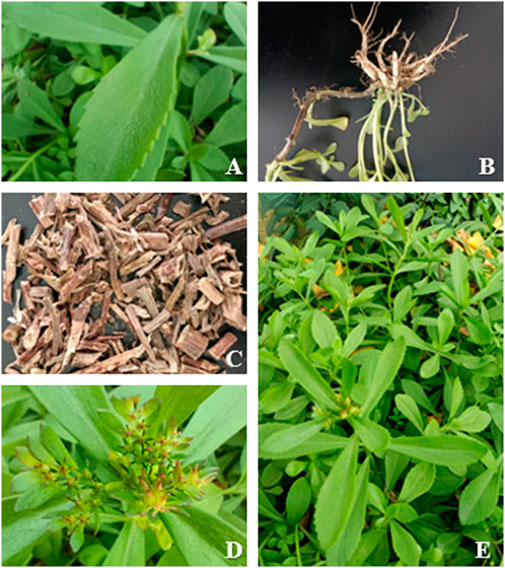
FIGURE 1. Morphological characteristics of S. aizoon: (A) leaves, (B) roots, (C) dry drug, (D) buds, and (E) whole plant.
6 Phytochemistry
Up to now, more than 234 metabolites, including flavonoids (1–48), phenolic acids (49–78), triterpenes and phytosterols (79–90), alkaloids (91–98), volatile constituents (99–216), and others (217–234), have been preliminarily isolated or identified from S. aizoon. Among these, flavonoids are the main metabolites of S. aizoon. The main metabolites and their structure are given in Table 1 and Figures 2–5.
6.1 Flavonoids
So far, 48 flavonoid metabolites (1–48) with definite structure have been isolated and identified from S. aizoon, which are grouped into flavonols (1–36), isoflavones (37–39), flavones (40–43), flavanonols (44–47), and flavan-3-ol (48). Among flavonols, rhamnazin-3-O-β-D-glucopyranoside (4), myricitrin (10), myricetin-3-O-α-L-arabinopyranoside (14) (Xiong et al., 2019), herbacetin-8-O-β-D-glucopyranoside (26), herbacetin-3-O-β-D-glucopyranosyl-8-O-α-L-arabinopyranoside (27), herbacetin-3-O-α-L-rhamnopyranosyl-8-O-α-D-lyxopyranoside (28), herbacetin-3-O-α-L-arabinopyranosyl-8-O-β-D-xylopyran-oside (29), gossypetin-3-O-β-D-glucopyranosyl-8-O-β-D-xylopyranoside (31), and 3′-methoxyl-gossypetin-3-O-β-D-glucopyranosyl-8-O-β-D-xylopyranosie (35) (Xu et al., 2015) were obtained mainly from the aerial part of S. aizoon. Later, Xu et al. (2019) successfully identified four flavonols [i.e., trifolin (1), rutin (2), astragalin (32), and isoquercitrin (5)], two flavones [i.e., lonicerin (43) and scutellarein (46)], and one isoflavone [i.e., genistein (39)] in the leaves and stems of S. aizoon. Two new prenylated isoflavones, sedacin A (37) sedacin B (38), and two flavonols, sedacin C (6″-O-(E)-feruloyl quercetin) (33) and sedacin D (6″-O-(E)-feruloyl isorhamnetin) (34), were isolated from the whole plant of S. aizoon (Li W. L. et al., 2011). Among them, sedacin A and sedacin B had the function of scavenging DPPH and ABTS+ free radicals (Li J. X. et al., 2011). Rhamnetin-3-O-β-D-glucopyranoside (3), quercetin-3-O-α-L-arabinopyranoside (8), isorhamnetin-3-O-β-D-xylopyranoside (22), and isorhamnetin-3-O-α-L-arabinopyranoside (23) have also been detected in rhizomes (Li et al., 2020a). Four flavanonols (44–47) with rare dimeric structures, with the character of an iriflophene unit and a flavonoid unit connecting via a furan ring, were isolated from the roots and identified using NMR, IR, UV, HRESIM, DEPT, HSQC, HMBC, and CD methods. In addition, studies were conducted to assess the activity of these four substances, and they revealed that 5a-(3,4-dihydroxyphenyl)-1,3,8,10,10b-pentahydroxy-9-(4-hydroxybenzoyl)-5a,10b-dihydro-11H-benzofurochromen-11-one (46) and 1,8,10,10b-tetrahydroxy-5a-(4-hydroxy-3-methoxyphenyl)-9-(4-hydroxybenzoyl)-3-methoxy-5a,10b-dihydro-11H-benzofuro[2,3-b]chromen-11-one (47) had good anti-proliferative activities in vitro against the tumor cell lines BXPC-3, A549, and MCF-7 (Li et al., 2017). The structures of flavonoids from S. aizoon are displayed in Figure 2.
6.2 Phenolic acids
Phenolic acids are the most important chemical derivatives of plant secondary metabolites. Currently, 31 phenolics (49–78) have been found from S. aizoon, including phenolic acids (49–58, 60), lignans (61), phenylpropanoids (59, 62–63), and other phenolics (64–78). Two phenolic acids, namely, sedumol (49) and 4-methoxy-3,5-dihydroxybenzoic acid (56) (Han et al., 2021), were obtained from the 95% ethanol extract of S. aizoon’s whole grass. Other phenolic acids, including vanillic acid (50) (Lin, 2014), protocatechuic acid (51), cis-4-coumaric acid (52), p-hydroxybenzoic acid (54) (Xiong et al., 2019), and caffeic acid (53) (Lin et al., 2014), were isolated from the aerial part of S. aizoon. Isolariciresinol-9-O-β-D-glucopyranoside (61) is classified as cyclolignans, which was obtained from the 70% ethanol extract via silica gel column chromatography (300–400 mesh). 2-O-(trans-caffeoyl)-malic acid 1,4-dimethyl ester (59) (Xiong et al., 2019), echinochlorin A (62) (Li et al., 2020a), 1-O-sinapoyl glucopyranoside (63) (Xu et al., 2015), and chrysophanol-8-O-β-D-glucoside (64) (Li et al., 2008) have been identified in S. aizoon. The structures of phenolic acids from S. aizoon are displayed in Figure 3.
6.3 Triterpenes and phytosterol
6.3.1 Triterpenes
A type of terpenoids known as triterpenoids has a parent nucleus that contains 30 carbon atoms. Triterpenoids exist in plants in free form or as glycosides or esters and have various biochemical activities. Up to now, eight triterpenes (79–86) were separated from S. aizoon, including one tetracyclic triterpenes (79) and seven pentacyclic triterpenes (80–86). The only tetracyclic triterpene, ginsenoside Re (79), is a dammarane-type triterpene. Seven pentacyclic triterpenes are divided into four groups: ursane type (80), oleanane type (81–83), friedelane type (84), and fernane type (85–86). In the studies of Li et al. (2008, 2020a), glutin-5-en-3-one (84), isomoliol-3β-acetate (86), taraxerone (82), and isomotiol (85) were isolated from S. aizoon for the first time. The structures of triterpenoids from S. aizoon are displayed in Figure 4.
6.3.2 Phytosterols
Up to now, a total of four phytosterols (87–90) have been identified in S. aizoon. These include β-sitosteryl linoleate (87) (Li et al., 2020a), daucosterol (89) (Guo et al., 2010; Lin et al., 2011), β-sitosterol (88), and stigmasterol (90) (Cao, 2011). The structures of phytosterol from S. aizoon are displayed in Figure 4.
6.4 Alkaloids
Eight alkaloids (91–98) have been isolated and identified from S. aizoon. In 1996, Kim et al. (1996) examined the alkaloids in Sedum species and discovered the presence of three alkaloids, namely, sedinine (91), sedamine (92), and despun methylisopelletierine (93) in S. aizoon. Thymine (95) was obtained from the ethyl acetate fraction of aqueous extracts of Sedum aizoon L. In the study of Gao et al. (2006), three pyrrolizidine alkaloids (PAs), namely, senecionine (96), seneciphylline (97), and integerrimine (98) were identified in the extracts of S. aizoon’s root, which had strong hepatotoxicity. The structures of alkaloids from S. aizoon are displayed in Figure 5.
7 Pharmacological activities
According to pharmacological studies, S. aizoon has a wide range of pharmacological activities, including antioxidant, anti-fatigue, and anti-inflammatory activities, improving cardiovascular disease, and other activities. The related biological activities and main effects are listed in Table 2.
7.1 Antioxidant activity
S. aizoon has excellent antioxidant activity, as demonstrated by several pharmacological studies in vitro and in vivo. An in-depth in vivo study showed that the juice from the stems and leaves of S. aizoon increased the peroxidase (POD) and superoxide dismutase (SOD) of the liver in Cyprinus carpio Linnaeus as well as reduced the content of malondialdehyde (MDA), thus preventing the peroxidation damage of the liver cell membrane (Zhang and Wang, 2012). Experimental tests in vivo showed that ethanol extracts of S. aizoon were able to enhance antioxidant enzymes in T1DM mice and successfully alter the Nrf2/Keap1/ARE signaling pathway (Qi et al., 2022). Additionally, 95% ethanol extract of S. aizoon increased the activity of SOD, CAT, and GSH-Px and reduced the contents of MDA and ROS on the rat adrenal pheochromocytoma cell line (PC12) induced by H2O2, showing a protective effect on the cell (Zhao, 2015).
7.2 Anti-fatigue effects
As national fitness activities expand, more individuals participate in sports, and the negative consequences of exercise fatigue on the body become more obvious. The effective recuperation of the body and the rapid removal of exercise exhaustion are becoming increasingly vital to society. The animal experiments (mice) demonstrated that the extracts of S. aizoon (3.6 and 0.9 mL/kg, 30 days) prolonged the time of extreme exercise in mice, reduced the contents of blood urea nitrogen (BUN), lactic acid (LAC), MDA, and lactate dehydrogenase (LDH) in the serum of mice, improved the activity of SOD and GSH-Px, and increased the contents of liver and muscle glycogen of mice (Ding, 2019). In a human clinical trial, it has been found that the administration of the sap (0.225 mL/kg.d, 0.9 mL/kg.d, and 3.6 mL/kg.d, 28 days) of the aerial part from S. aizoon [5 mL/(60 kg.d), 14 days] reduced the response time of male college students to the stimulus signal, improved fatigue resistance, and accelerated fatigue recovery by decreasing the content of blood perfusion index, cortisol, and creatine kinase in the serum and increasing hemoglobin and the load of final exercise (Ren, 2020). The above studies showed that S. aizoon improved exercise endurance, affected their metabolic activity, and produced anti-fatigue effect. S. aizoon’s probable anti-fatigue effects of action are shown in Figure 6.
7.3 Hemostatic activity
S. aizoon has an effect comparable to that of Notoginseng Radix in terms of reducing bleeding without causing stasis and nourishing blood. A series of experiments in vivo and in vitro revealed that extracts and preparations of S. aizoon exhibited good hemostatic activities. Previous studies showed that alcohol and aqueous extracts (6, 12 g/kg b.w) of S. aizoon could significantly shorten the bleeding time and clotting time of mice (Chen et al., 2012). The juice of the whole herb from S. aizoon could increase the levels of GP Ⅱb/Ⅲa, P selectin, and ET-1 and the number of platelets and enhance the platelet aggregation and release function of the rats with aspirin-induced gastric hemorrhage, thus achieving hemostasis. Since S. aizoon could increase the level of IL-8, it was used in patients with bleeding accompanied by inflammation (Huang, 2014).
S. aizoon combined with other drugs can also be used for the treatment of bleeding diseases. Patients with bleeding peptic ulcers was treated upon treatments with herbs S. aizoon in conjunction with omeprazole (Xu, 2012). After intravenous injection in rabbits and intraperitoneal injection in mice of S. aizoon syrup, the blood coagulation time and bleeding time were decreased (Chinese Academy of Medical Sciences, 1972). The probable hemostatic mechanism is shown in Figure 7.
7.4 Antimicrobial activity
The crude extracts from S. aizoon have antimicrobial activity. According to transcriptome and RNA sequencing analyses, the ethanol extracts extracted from S. aizoon had significant antimicrobial activities against B. cinerea (Wang K. et al., 2022), Aeromonas (Xu et al., 2019), postharvest citrus blue mold (Luo et al., 2020), Shewanella putrefaciens (Wang et al., 2020), and Pseudomonas fragi (Wang H. X. et al., 2022). Studies revealed that alcohol extracts had a good inhibitory ability against 20 strains of multidrug-resistant Pseudomonas aeruginosa (MIC50 value = 0.125 g/mL) (Zhang et al., 2012; Wang H. et al., 2023), Staphylococcus aureus, Staphylococcus epidermidis, and Micrococcus (MIC value = 0.125 g/mL). However, the inhibitory impact on three types of fungus, including Candida tropicalis, Candida parapsilosis, and Candida albicans, was very poor, with MIC values above 0.5 g/mL (Zhang et al., 2011).
Furthermore, monomer metabolites isolated from S. aizoon also have antimicrobial activity. Xu et al. (2015) revealed that herbacetin-3-O-α-L-rhamnopyranosyl-8-O-α-D-lyxopyranoside (28), myricetin-3-O-β-D-glucopyranoside (12), and gossypetin-3-O-β-D-glucopyranosyl-8-O-β-D-xylopyranoside (31) exhibited more potency against Gram-positive than against Gram-negative bacteria. S. aizoon’s probable antimicrobial actions are shown in Figure 8.
7.5 Sedative and hypnotic effects
Traditional Chinese medicine and its preparations are commonly used to treat sleeplessness, agitation, and other symptoms. They offer the benefits of safety and dependability, as well as fewer toxicity and side effects, as compared to Western medication with sedative and hypnotic properties. Using the mouse model, Guo et al. (2009) showed that the water and alcohol extracts have tranquilizing mind and the calming effects. Later, they also found that the ethyl acetate and butanol extracts could effectively lower the autonomic activity in mice, lengthen sleeping duration in mice, and increase the number of sleeping mice (Guo et al., 2010).
Additionally, the S. aizoon’s prescription or in combination with other drugs also possess sedative and hypnotic properties, which are often used to treat sleeplessness, restlessness, and other disorders. For instance, Yangxincao Anshen Granules made with S. aizoon (12, 6 g/kg/d) significantly reduced the spontaneous movements of mice, and the granules, in conjunction with pentobarbital, extended the duration of their sleep, providing good sedative and hypnotic effects without negative side effects (Zhang R. Z. et al., 2015). Similar results have been recorded for the combination between S. aizoon and Semen ziziphus spinosa (Zhang L. et al., 2015).
7.6 Anti-cancer activity
S. aizoon’s active metabolites and crude extracts with anti-cancer potential have piqued the interests of researchers in recent years. The ethanol extracts isolated from S. aizoon (50, 100, and 200 μg/mL) could lower the survival rate of human liver cancer cells HepG2 and inhibit human hepatocarcinoma proliferation by 11.15%, 41.96%, and 52.04%, respectively. With the increase in concentration, the inhibition rate of liver cancer cells increased, showing a certain dose–effect relationship (Wang et al., 2013). The aqueous extracts of S. aizoon [equivalent to adding 15.9 mg raw drug, containing 31.7 μg gallic acid (60)] could destroy the phospholipid-dominated structures and block nucleic acid synthesis and metabolism, which caused the death of cancer cells, and the killing effect was improved when the drug treatment period was extended (Fu et al., 2008).
Among the active metabolites tested, myricetin-3-O-D-glucopyranoside (12) obtained from the aerial portion of S. aizoon exhibited an effect on cell proliferation against HepG2, MCF-7, and A549 tumor cells, with IC50 values of 46.30, 75.27, and 49.76 mol/L, respectively (Xu et al., 2015). Li et al. (2017) found that 5a-(3,4-dihydroxyphenyl)-1,3,8,10,10b-pentahydroxy-9-(4-hydroxybenzoyl)-5a,10b-dihydro-11H-benzofuro chromen-11-one, an iriflophene unit, and a quercetin unit connecting via a furan ring (44) and 1,8,10,10b-tetrahydroxy-5a-(4-hydroxy-3-methoxyphenyl)-9-(4-hydroxybenzoyl)-3-methoxy-5a,10b-dihydro-11H-benzofuro[2,3-b]chromen-11-one, an iriflophene unit, and a rhamnazin unit connecting via a furan ring (47) isolated from the roots of S. aizoon exhibited cytotoxic activities against BXPC-3, A549, and MCF-7 tumor cell lines, with IC50 ranging from 24.84 to 37.22 μmol/L. S. aizoon’s probable anti-cancer actions are shown in Figure 9.
7.7 Anti-inflammatory effect
In Northeast Asia, S. aizoon has been used as a traditional medicine to treat inflammatory illnesses. Several extracts (PE, EtOAc, and H2O) of S. aizoon were administered to LPS-stimulated RAW 264.7 cells to investigate anti-inflammatory activities. The phenolic and flavonoid-rich EtOAc extracts reduced NO, TNF-α, and IL-6 production induced by LPS (Lin et al., 2015a). In a study by Kim et al. (2004), methanol extracts of S. kamtschaticum Fischer showed a significant inhibitory effect in the inflammation models of mouse ear edema (50–400 mg/kg for 3 days) and rat paw edema (400–800 mg/kg for 3 days) induced by croton oil and multiple phorbol ester. The cyclooxygenase-2 expression was downregulated. Possible mechanisms of action are given in Figure 10.
7.8 Cardioprotective effects
S. aizoon lowered blood pressure, serum CK activity, and AT1 protein expression, reversed myocardial remodeling, and increased AT2 and catalase protein expression (Han et al., 2022). Chen (2000) showed that fresh S. aizoon grass could help stroke victims regain consciousness. It is thought that this herb has evident effects in improving blood circulation, reducing blood stasis, and decreasing blood pressure. Using the method of network pharmacology and molecular docking, studies found that S. aizoon had the effect of treating atherosclerosis and coronary heart disease (Zhu et al., 2022, 2023).
Interestingly, the extract of S. aizoon increased cardiac activity and decreased amphetamine toxicity (Zheng, 1975). According to the study of Wang et al. (2013), S. aizoon had the ability to regulating blood lipid levels and could dramatically lower the mice’s liver index and fat coefficient. Additionally, when hyperlipidemia rats were treated with Yangxincao capsules (derived from whole grass extract), the serum levels of TC, TG, and LDL-C were decreased, while HDL-c and its subcomponents (HDL-c, HDL-3-C, and HDL-C/TC) were increased, implying that the mechanism of lipid regulation of S. aizoon was related to the enhancement of the activities of LPL, LCAT, and HDL2-C (Wu et al., 2006).
7.9 Other activities
In T1MD mice, it has been shown that S. aizoon extract has the ability to enhance glucolipid metabolism and organ coefficient and decrease liver tissue damage (Qi et al., 2022). In addition, polysaccharides from S. aizoon have an immune-stimulating effect by increasing the thymus index, spleen index, T- and B-lymphocyte transformation proliferation, and NK cell activity of mice, as well as enhancing the percentage values of CD3+, CD4+, and CD19+ and the percentage values of CD4+/CD8+ in the peripheral blood. Such effect was associated with the increased secretion of IL-2 and IFN-γ(Huang, 2019).
8 Acute toxicity
A previous study showed that excessive consumption may cause small hepatic vein occlusion disease with upper quadrant abdominal pain, hepatomegaly, liver dysfunction, and ascites as the main symptoms (Wu et al., 2008; Shao et al., 2015).
9 Quality control
The quality of traditional Chinese medicine is the basis for ensuring the stability of its efficacy and the safety of its application, and its standardization and modernization are the important prerequisites for promoting Chinese medicine toward internationalization. In order to better identify the plant, Scholars (Han, 2008) have controlled the quality of S. aizoon from four aspects: morphology, microscopy, TLC, and RAPD. It is required that the water content shall not exceed 10.53%, the ash content shall not exceed 14.70%, and the leaching content shall not be less than 32.57% (Wei et al., 2020). The linear ranges of quercitroside, quercetin, and kaempferol were 0.0029 ∼ 0.183, 0.0016 ∼ 0.1020, and 0.0045 ∼ 0.260 μg/μL, respectively (He and Du, 2016), and those of luteolin and isorhamnetin were 1.12 ∼ 112.00 and 0.98 ∼ 97.60 μg/mL (Lin et al., 2013), respectively. However, these methods may not be sufficient to evaluate the quality of S. aizoon.
Traditional Chinese medicine (TCM) fingerprints can comprehensively and quantitatively reflect the chemical information contained in TCM and is an effective means of quality control of TCM. Lin et al. (2015b) used 11 standards to analyze the phytochemical profiles of the active extracts by HPLC fingerprints. Yang et al. (2023) established the HPLC-ECD fingerprint spectra of S. aizoon from different origins and identified 12 metabolites.
10 Conclusion and future perspectives
This review provides comprehensive and detailed information about the history, traditional uses, botany, phytochemistry, pharmacological activities, and acute toxicity of S. aizoon. So far, more than 200 metabolites have been identified with a variety of pharmacological activities. These modern pharmacological studies supported most traditional uses of S. aizoon as folk medicine. However, gaps still exist in the systematic study of S. aizoon.
First, S. aizoon has many nicknames, which results in being mixed with other herbs. Therefore, molecular biological studies are required to screen out the reference genes for better identification of S. aizoon.
Second, the pharmacological potential of S. aizoon has not yet been fully discovered, which may be further investigated by a combination of in vitro and in vivo bioactivity assays, metabolomics, network pharmacology, and in silico bioactivity prediction methods. In addition, the therapeutic potential of S. aizoon and its bioactive metabolites, safety, efficacy, and potential mechanism of action require further preclinical and clinical studies to validate for future clinical applications.
Third, S. aizoon is widely popular in herbal healthcare as a commonly used medicinal and edible substance and is especially used in immunomodulation and blood lipid regulation. Nevertheless, the use of S. aizoon in combination with other herbs in healthcare products should be strengthened, and studies on improving memory and promoting digestion may be conducted.
Fourth, the spectrum–efficacy relationship of S. aizoon in immunomodulation and anti-inflammatory therapy should be further investigated in order to better uncover its active metabolites.
Author contributions
B-LW: conceptualization, funding acquisition, methodology, and writing–original draft. Z-KG: writing–review and editing, formal analysis and validation. J-RQ: writing–review and editing, formal analysis and validation. S-QL: data curation, investigation, visualization, and writing–original draft. X-CH: funding acquisition and writing–review and editing. Y-HZ: writing–review and editing and visualization.
Funding
The authors declare that financial support was received for the research, authorship, and/or publication of this article. This research was carried out with the support of the Natural Science Foundation of Hubei Provincial Department of Education, grant number B2020104, the Innovation and Entrepreneurship Training Program for college students of Hubei University of Medicine, grant number X202110929016, and Hubei Key Laboratory of Wudang Local Chinese Medicine Research (Hubei University of Medicine), grant number WDCM2023025.
Conflict of interest
The authors declare that the research was conducted in the absence of any commercial or financial relationships that could be construed as a potential conflict of interest.
Publisher’s note
All claims expressed in this article are solely those of the authors and do not necessarily represent those of their affiliated organizations, or those of the publisher, the editors, and the reviewers. Any product that may be evaluated in this article, or claim that may be made by its manufacturer, is not guaranteed or endorsed by the publisher.
References
Bai, Y. L., Sun, T., Wang, Y. X., Liu, Z. Y., and Zheng, W. Z. (2016). Effect of sedum aizoon L. On platelet and vessel wall function in rats with gastrointestinal tract hemorrhage induced by aspirin. Lab. Med. 31, 131–134doi:10.3969/j.issn.1673-8640.2016.02.013
Cao, N. F. (2011). Studies on bioactive constituents of sedum Aizoon and Euphorbia humifusa. Master: Henan University.
Chen, E. D., Wang, X. M., Gong, L. L., Li, H. F., Rong, R., and Jiang, H. Q. (2014). Analysis of volatile components of above-ground parts of sedum aizoon by gas chromatography-mass spectrometry. Shandong J. Traditional Chin. Med. 33, 491–492. doi:10.16295/j.cnki.0257-358x.2014.06.001
Chen, K. K., and Qiang, Y. (2017). GC-MS analysis of fat soluble components from different parts of sedum aizoon. China J. Exp. Traditional Med. Formulae 23, 77–81. doi:10.13422/j.cnki.syfjx.2017200077
Chen, W. L., Qiu, Q., Lin, Z. C., and Guo, S. H. (2012). Screening of hemostasis effective fraction from sedum aizoon L. J. Zhejiang Chin. Med. Univ. 36, 182–183. doi:10.16466/j.issn1005-5509.2012.02.032
Chinese Academy of Medical Sciences, I.O.M.M (1972). Study on Chinese pharmaceutical active component (volume one). Beijing: People's Medical Publishing House, 424.
Chinese Herbal Medicine Research Group (1971). Clinical observation on hemostatic effect of herbal sedum aizoon. J. New Med., 14–15.
Chinese Pharmacopoeia Committee (2005). Chinese Pharmacopoeia. Beijing: Chinese Medical Science and Technology Press, 590–591.
Ding, Q. (2019). Experimental study on anti-exercise-induced fatigue of jingtian panax Notoginseng. Beijing: Capital University of Physical Education and Sports.
Fu, Y. R., Bo, A. H., Sun, L., Guo, C. Y., Bai, X. M., and Li, H. F. (2008). The effect of tusanqi on ultrastructure of esophageal carcinama cells. Lishizhen Med. Mater. Med. Res. 150, 368–369.
Gao, X. S., Xiao, S. S., and He, J. F. (2006). Analysis of alkaloids in sedum aizoon and establishment of hepatic veno-occlusive model in mice. Chin. J. Integr. T Rad. West Med. Dig., 311–313.
Ge, Q., Wang, K., Shao, X., Wei, Y., Zhang, X., Liu, Y., et al. (2023). Inhibitory mechanism of flavonoids from sedum aizoon L. On rhizopus nigricans. Foodborne Pathog. Dis. 20, 197–208. doi:10.1089/fpd.2022.0083
Gong, P. J. (2020). Analysis of cutting propagation technique and principal nutrient components of excellent sedum aizoon variety. J. Shandong For. Sci. Technol. 50, 56–58.
Guo, S. H., Che, S. R., Zhu, Y. Q., Zhang, N., and Wang, Y. H. (2006). Analysis of the chemical composition of the volatile oil of sedum aizoon by gas phase - mass spectrometry. China J. Traditional Chin. Med. Pharm., 689–690.
Guo, S. H., Huang, H. H., Lin, D., and Xu, F. (2010). Sedative and hypnotic effects of different extracted parts of sedum aizoon L. In mice. J. Fujian Univ. Tradit. Chin. Med. 20, 22–23. doi:10.13261/j.cnki.jfutcm.002315
Guo, S. H., Huang, H. H., Xu, F., and Lin, D. (2009). Pharmacodynamic comparison of tranquilizing mind effect between water extract and alcohol extract of sedum aizoon L. J. Fujian Univ. Tradit. Chin. Med. 19, 28–29. doi:10.13261/j.cnki.jfutcm.002205
Guo, S. H., and Lin, Z. C. (2007). Studies on quality standard of sedum aizoon L. China J. Traditional Chin. Med. Pharm., 761–763.
Han, R. C. (2008). Study on the pharmacognosy of four species plants of sedum L. Master. Liaoning: Liaoning University Of Traditional Chinese Medicine.
Han, R. J., Zhao, C., Chen, H. J., Sun, Y. J., Chen, H., Li, M., et al. (2021). Study on chemical constituents from sedum aizoon L. Chin. J. Tradit. Chin. Med. Pharm. 36, 4223–4226.
Han, W., Li, M. X., Lv, C. N., Hao, Y. M., and Lu, J. C. (2017). Study on chemical constituents from stems and leaves of sedum aizoon L. Chin. Med. Her. 14, 33–36.
Han, W. D., Xue, S., Chen, J. Y., He, Z. L., Zhao, X. M., Tan, R., et al. (2022). Analysis of the therapeutic effect of sedum aizoon L. On hypertension and its active ingredients. Renowned Dr. No 130, 42–44.
He, J. J., and Du, J. (2016). Simultaneous determinate the content of quercetin, quercitroside and kaempferol in sedum aizoon L. By HPLC. Lishizhen Med. Materia Medica Res. 27, 524–526. doi:10.3969/j.issn.1008-0805.2016.03.005
Huang, A. Y. (2014). “Study on ethyl acetate parts of hemostatic and anti-inflammatory effect of sedum aizoon L,” in Activity screening. Master (Fujian: Fujian University of Traditional Chinese Medicine).
Huang, R. (2019). Study on the immunological activity of feicai polysaccharide. Master. Jilin: Yanbian University.
Jia, L. Y., Xu, T. Y., Wang, J., Lv, C. N., and Lu, J. C. (2014). Chemical constituents from the stems and leaves of sedum aizoon L (Ⅱ), 31. Liaoning: Journal of Shenyang Pharmaceutical University, 673–676.
Kim, D. W., Son, K. H., Chang, H. W., Bae, K., Kang, S. S., and Kim, H. P. (2004). Anti-inflammatory activity of Sedum kamtschaticum. J. Ethnopharmacol. 90, 409–414. doi:10.1016/j.jep.2003.11.005
Kim, J. H., Thart, H., and Stevens, J. F. (1996). Alkaloids of some asian sedum species. Phytochemistry 41, 1319–1324. doi:10.1016/0031-9422(95)00562-5
Li, M., Qi, Z., Hao, Y., Lv, C., Jia, L., Wang, J., et al. (2017). New adducts of iriflophene and flavonoids isolated from sedum aizoon L. With potential antitumor activity. Molecules 22, 1859. doi:10.3390/molecules22111859
Li, Q., Yu, Y., Li, M. X., Xu, T. Y., Lu, J. C., and Lv, C. N. (2020a). Isolation and ldentification of the chemical constituents from the rhizome of sedum aizoon L. Mod. Chin. Med. 22, 353–357. doi:10.13313/j.issn.1673-4890.20191203001
Li, Q. Y., and Wu, L. Q. (2011). Two new prenylated isoflavones from sedum aizoon L. Fitoterapia 82, 405–407. doi:10.1016/j.fitote.2010.11.021
Li, J. X., Cao, N. F., and Kang, W. Y. (2011). Antioxidant activity of sedum aizoon L. From henan. Nat. Prod. Res. Dev. 23, 337–340. doi:10.16333/j.1001-6880.2011.02.033
Li, W. L., Jing, Y., Luo, Q. Y., Bai, S. P., and Yan, F. L. (2008). Study of chemical constituents on sedum aizoon L. J. Xinxiang Med. Univ. 25, 558–561.
Li, W. L., Luo, Q. Y., Wu, L. Q., and Xiao, L. (2011). Two new flavonol glycosides from. Sedum Aizoon L. Heterocycles. 83, 135–141.
Li, Z. H., Hu, H. B., Chen, J., Wang, M. Q., and Du, G. H. (2007). Analysis of the constituents in sedum aizoon L. By HPLC ESI-MS/MS. Chin. J. Nat. Med., 431–434.
Lin, Z., Fang, Y., Huang, A., Chen, L., Guo, S., and Chen, J. (2014). Chemical constituents from sedum aizoon and their hemostatic activity. Pharm. Biol. 52, 1429–1434. doi:10.3109/13880209.2014.895019
Lin, Z. C. (2014). Studies on hemostatic and anti-inflammatory effective substances of sedum aizoon L. And its quality evaluation. Nanjing, China: Nanjing University of Chinese Medicine.
Lin, Z. C., Fang, Y. J., Huang, A. Y., Chen, L. Y., and Guo, S. H. (2013). Simultaneous determination of four flavonoids in sedum aizoon L. From different origin and medicinal parts by high performance liquid chromatography. J. Anal. Sci. 29, 819–822.
Lin, Z. C., Huang, H. H., Chen, D. W., Chen, J. H., and Guo, S. H. (2011). Study on chemical constituents of active parts of calming the heart and tranquilizing the mind from sedum aizoon L. China J. Traditional Chin. Med. Pharm. 26, 3000–3002.
Lin, Z. C., Zhang, L., Zhang, R. Z., Huang, A. Y., and Guo, S. H. (2015a). Anti-inflammatory effect of ethyl acetate extract of sedum aizoon L. LPS-stimulated RAW 264. 7 macrophages and its HPLC fingerprint. J. Chin. Pharm. Sci. 24, 647–653.
Lin, Z. C., Zhang, L., Zhang, R. Z., Huang, A. Y., and Guo, S. H. (2015b). Antiinflammatory effect of ethyl acetate extract of sedum aizoon L. In LPS stimulated RAW 264.7 macrophages and its HPLC fingerprint. J. Chin. Pharm. Sci. 24, 647–653. doi:10.5246/jcps.2015.10.082
Liu, K. Q., Yin, W. D., Zheng, H. Z., and Shi, Y. W. (2011). The influence of jingtiansanqi on platelet and coagulation function in rat treated with aspirin. Labeled Immunoassays Clin. Med. 18, 407–410.
Liu, X. F., Ma, Z. R., Wu, X. Q., Lai, M. Q., and Zhang, Y. (2012). Research progress of active principle and functional compounds of sedum aizoon L. China J. Traditional Chin. Med. Pharm. 27, 2135–2138.
Liu, X. M., Wu, F. H., and Huang, Q. F. (2005). Pharmacodynamic study on regulating lipid of Yangxincao capsule. Chin. J. Pathophysiol. 21, 1628.
Liu, Z. K., Min, C., Dong, H., and Zhang, Z. S. (2021). Improvement of adventitious root formation in sedum aizoon L. And the production of flavonoids. South Afr. J. Bot. 137, 483–491. doi:10.1016/j.sajb.2020.10.024
Liu, Z. Y., Wang, Y. X., Sun, T., Bai, Y. L., and Zheng, W. Z. (2015). Observation the effect of jingtian sanqi on hamostatic function and coagulation in rats with gastric hemorrhage. Chin. Med. Mod. Distance Educ. China 13, 142–144. doi:10.3969/j.issn.1672-2779.2015.13.072
Luo, J., Xu, F., Zhang, X., Shao, X., Wei, Y., and Wang, H. (2020). Transcriptome analysis of penicillium italicum in response to the flavonoids from sedum aizoon L. World J. Microbiol. Biotechnol. 36, 62. doi:10.1007/s11274-020-02836-z
Ma, J., Gao, L., Shi, Y., Cai, D. B., and Xiong, S. L. (2019). Purification, free radical scavenging activity and preliminary identification of ethanol extract s from sedum aizoon L. Sci. Technol. Food Ind. 40, 207–213+219. doi:10.13386/j.issn1002-0306.2019.04.034
Qi, X., Lu, X. T., Sun, X. H., Lin, C. Q., and Cui, C. B. (2022). The regulatory effect of total flavonoids of sedum aizoon L. On oxidative stress in type 1 diabetic mice. Curr. Res. Food Sci. 5, 1140–1147. doi:10.1016/j.crfs.2022.06.010
Qian, Y. X., Li, Y., and Guo, D. G. (2018). An analysis of chemical constituents of volatile oil of sedum aizoon L. J. Guiyang Coll. Tradit. Chin. Med. 40, 47–49. doi:10.16588/j.cnki.issn1002-1108.2018.01.012
Qiang, Y. (2013). Study on germplasm resources and bioactive components of sedum aizoon L. Doctor Shaanxi: Shaanxi Normal University.
Ren, M. J. (2020). Experimental study on the preventive effect of sedum aizoon L. On exercise fatigue in mice and humans. Master. Beijing: Capital University of Physical Education and Sports.
Shao, H., Chen, H. Z., Zhu, J. S., Ruan, B., Zhang, Z. Q., Lin, X., et al. (2015). Computed tomography findings of hepatic veno-occlusive disease caused by sedum aizoon with histopathological correlation. Braz J. Med. Biol. Res. 48, 1145–1150. doi:10.1590/1414-431X20154563
Tan, B., He, X. C., Li, T., and Du, J. (2018). Research progress on chemical constituents and medical functions of phedimus aizoon. Chin. J. Ethnomedicine Ethnopharmacy 27, 49–52.
Tan, P., Yao, L. F., and Peng, C. X. (2001). MIC test on 40 species of ''Qi" herbs from Mt▪Qinling. Hubei: Lishizhen Medicine and Materia Medica Research, 484–485.
Wang, H., Ge, Q., Shao, X., Wei, Y., Zhang, X., Wang, H., et al. (2023a). Influences of flavonoids from sedum aizoon L. On biofilm formation of Pseudomonas fragi. Appl. Microbiol. Biotechnol. 107, 3687–3697. doi:10.1007/s00253-023-12526-z
Wang, H. F., Liu, F., Xu, C., Lin, Y., Li, H. S., Shao, X. F., et al. (2013). Study on blood lipid regulation and hepatocarcinoma proliferation of total flavonoid from sedum aizoon L. J. Chin. Inst. Food Sci. Tech. 13, 23–27. doi:10.16429/j.1009-7848.2013.04.002
Wang, H. X., Xu, F., Zhang, X., Shao, X. F., Wei, Y. Y., and Wang, H. F. (2022a). Transcriptomic analysis reveals antibacterial mechanism of flavonoids from sedum aizoon L. Against Pseudomonas fragi. Food control. 134, 108755. doi:10.1016/j.foodcont.2021.108755
Wang, J., Chi, Z., Zhao, K., Wang, H., Zhang, X., Xu, F., et al. (2020). A transcriptome analysis of the antibacterial mechanism of flavonoids from sedum aizoon L. Against Shewanella putrefaciens. World J. Microbiol. Biotechnol. 36, 94. doi:10.1007/s11274-020-02871-w
Wang, K., Zhang, X., Shao, X., Wei, Y., Xu, F., and Wang, H. (2022b). Flavonoids from sedum aizoon L. Inhibit botrytis cinerea by negatively affecting cell membrane lipid metabolism. Appl. Microbiol. Biotechnol. 106, 7139–7151. doi:10.1007/s00253-022-12196-3
Wang, K. Y., Ge, Q. Q., Shao, X. F., Wei, Y. Y., Zhang, X., Xu, F., et al. (2023c). Influences of flavonoids from sedum aizoon L. On the cell membrane of botrytis cinerea. Food Biosci. 52, 102386. doi:10.1016/j.fbio.2023.102386
Wang, X. H. (2013). Processing technology of leaf tea and its beverage of sedum aizoon L. Master Shandong: Shandong Agricultural University.
Wei, X., Liu, C., Yao, Y. M., Liu, X. L., and Peng, L. J. (2020). Stduy on quality standard of sedum aizoon. Stud. Trace Elem. Health 37, 39–40+43.
Wu, F. H., Liu, X. M., and Guo, S. H. (2006). Study on mechanism of Yangxincao capsule in regulating lipid metabolism. Chin. J. Integr. Tradit. West. Med. 26, 131–134.
Wu, G. L., Yu, G. Y., and Chen, J. (2008). Clinical analysis of hepatic veno-occlusive disease induced by sedum aizoon. China J. Chin. materia medica 33, 2402–2404.
Xiong, Y., Du, C. X., Duan, Y. S., Yuan, C. M., Huang, L. J., Gu, W., et al. (2019). Chemical constituents and pharmacological activities of sedum aizoon form guizhou province. Chin. Tradit. Herb. Drugs. 50, 5404–5410.
Xu, F., Cao, S., Wang, C., Wang, K., Wei, Y., Shao, X., et al. (2019). Antimicrobial activity of flavonoids from sedum aizoon L. Against Aeromonas in culture medium and in frozen pork. Food Sci. Nutr. 7, 3224–3232. doi:10.1002/fsn3.1178
Xu, L. (2012). Evaluation of herb sedi aizoon in the treatment of peptic ulcer bleeding. Hainan Med. J. 23, 32–33.
Xu, T., Wang, Z., Lei, T., Lv, C., Wang, J., and Lu, J. (2015). New flavonoid glycosides from sedum aizoon L. Fitoterapia 101, 125–132. doi:10.1016/j.fitote.2014.12.014
Xu, Z. C., Wen, Y. H., Li, M. J., Liang, S., Wei, Y., and Zheng, W. Z. (2016). Study on hemostatic and activating blood effect and mechanism of jingtiansanqi in rat treated with aspirin. Lishizhen Med. Mater. Med. Res. 27, 84–85.
Xuan, X. M. (2014). Experimental study on anti-atherosclerotic effect of total phenolic acid in the sedum aizoon L. Clin. J. Chin. Med. 6, 139–141.
Xuan, X. M. (2015). The observation of the clinical efficacy of gynurajaponica in the treatment of cardiovascular diseases. J. North Pharm. 12, 28–29.
Xue, G. X. (2015). Research of fermented Sedum kamtschaticum tea beverage. China Brew. 34, 151–155. doi:10.11882/j.issn.0254-5071.2015.10.034
Yang, X. J., Wang, Y., Chen, Z. H., Liu, M. Y., Wu, J., Xiang, Y., et al. (2023). Study on the spectrum effect relationship of antioxidant activity of sedum aizoon L. Based on HPLC-ECD. Sci. Technol. Food Industry 44, 15–24. doi:10.13386/j.issn1002-0306.2022100158
Yi, Y. J. (2000). Utilization value and planting of sedum aizoon. Special Econ. Animal Plant 3 (4), 38.
Zhang, G. S., and Wang, G. P. (2012). Effect of sedum aizoon L. On the antioxidase activity and MDA content of the liver in Cyprinus carpio Linnaeus. Sichuan J. Zoology 31, 909–911. doi:10.3969/j.issn.1000–7083.2012.06.013
Zhang, J. J., Wang, J., Xue, J., Cao, B. Y., and Lu, J. C. (2010). Chemical constituents from the stems and leaves of sedum aizoon L, 27. Journal of Shenyang Pharmaceutical University, 635–638.
Zhang, L., Lin, Z. C., Zhang, R. Z., and Guo, S. H. (2015a). Experimental study of the hypnotic effect of the compatibility of sedum aizoon L. And semen ziziphus spinosa by increase-decrease baseline geometric proportion design method. Strait Pharm. J. 27, 17–18.
Zhang, R. Z., Lin, Z. C., Qiu, Q., Zhang, L., and Guo, S. H. (2015b). Study on the sedative-hypnotic effect and acute toxicity of Yangxincao anshen granule. J. Liaoning Univ. Tradit. Chin. Med. 17, 31–33. doi:10.13194/j.issn.1673-842x.2015.11.010
Zhang, Y. X., Qiao, H. Y., Shan, Y. Q., Liu, W. J., Liu, Z. X., and Kang, M. (2011). Experimental study on the anti-bacteria effects of sedum aizoon L. in vitro. J. Hebei North Univ.:Nat. Sci. 27, 78–80.
Zhang, Y. X., Xu, X. H., Qiao, H. X., and Zhang, Y. T. (2012). Study on antibacterial activity of Sedum Aizoon L. against multi - drug resistant Pseudomonas aeruginosa. J. Hebei North Univ.:Nat. Sci. 28, 76–78. doi:10.3969/j.issn.1673-1492.2012.04.022
Zhao, C. S. (2015). Study on protective effect of total flavonoids of sedum aizoon L. On oxidative damage of rat pheochromocytoma cells induced by hydrogen peroxide. Chin. Remed. Clin. 15, 1268–1269. doi:10.11655/zgywylc2015.09.017
Zheng, H. C. (1975). Research of phytochemistry and biological action of sedum. J. Int. Pharm. Res., 32–34. doi:10.13220/j.cnki.jipr.1975.01.006
Zhong, L. M., Xia, X. H., Jiang, D. J., Zeng, G. R., and Gao, S. (2014). Study on gastric- mucosal protective effect of different extracting-parts of stonecrop Notoginseng in mice. Chin. J. Clin. Pharmacol. 30, 208–211. doi:10.13699/j.cnki.1001-6821.2014.03.001
Zhu, B. J., Nai, G. Y., Pan, T. X., Ma, Z. F., Huang, Z. D., Shi, Z. Z., et al. (2022). To explore the active constituents of Sedum aizoon L in the treatment of coronary heart disease based on network pharmacology and molecular docking methodology. Ann. Transl. Med. 10, 1327. doi:10.21037/atm-22-5391
Zhu, B. J., Nai, G. Y., Pan, T. X., Ma, Z. F., and Zhou, W. J. (2023). Combining network pharmacology and bioinformatics to identify bioactive compounds and potential mechanisms of action of sedum aizoon L. In the treatment of atherosclerosis. Qual. Assur. Saf. Crops Foods 15, 104–116. doi:10.15586/qas.v15i3.1333
Glossary
Keywords: Sedum aizoon L., pharmacological activities, quality control, hemostatic activity, active metabolites
Citation: Wang B-L, Ge Z-K, Qiu J-R, Luan S-Q, Hao X-C and Zhao Y-H (2024) Sedum aizoon L.: a review of its history, traditional uses, nutritional value, botany, phytochemistry, pharmacology, toxicology, and quality control. Front. Pharmacol. 15:1349032. doi: 10.3389/fphar.2024.1349032
Received: 04 December 2023; Accepted: 16 February 2024;
Published: 14 March 2024.
Edited by:
Karim Hosni, Institut National de Recherche et d’Analyse Physico-Chimique (INRAP), TunisiaReviewed by:
Guangqiang Ma, Jiangxi University of Traditional Chinese Medicine, ChinaSen Zhang, Nanjing University of Chinese Medicine, China
Copyright © 2024 Wang, Ge, Qiu, Luan, Hao and Zhao. This is an open-access article distributed under the terms of the Creative Commons Attribution License (CC BY). The use, distribution or reproduction in other forums is permitted, provided the original author(s) and the copyright owner(s) are credited and that the original publication in this journal is cited, in accordance with accepted academic practice. No use, distribution or reproduction is permitted which does not comply with these terms.
*Correspondence: Xin-Cai Hao, aGFveGluY2FpNjY2QDE2My5jb20=; Yong-Heng Zhao, MjAxNDA1MTVAaGJtdS5lZHUuY24=
†These authors have contributed equally to this work
 Bai-Ling Wang
Bai-Ling Wang Zhen-Kai Ge1
Zhen-Kai Ge1 Yong-Heng Zhao
Yong-Heng Zhao